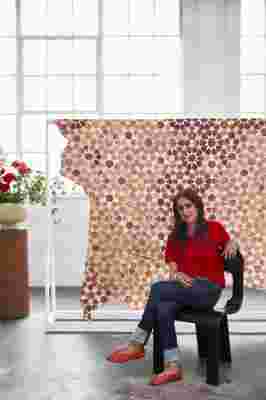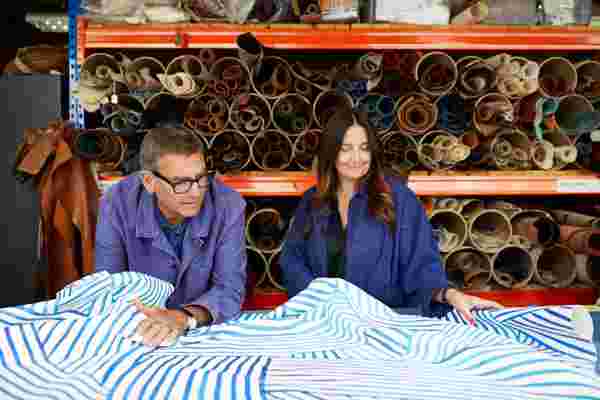Moore & Giles Unveils an Array of Playfully Patterned Leathers
Printing on leather allowed the same subtlety in color and texture that I find on paper,” reflects artist Amber Khokhar . “It enabled me to paint as I normally paint.” She is one of five U.K.-based talents who have collaborated with the British leather specialist Bill Amberg to create a new collection of vividly patterned, digitally printed hides for Moore & Giles .

Designer Amber Khokhar with a version of her D ecagram leather, developed around a 10-point-star motif.
Realized using natural pigments, her constellation of stars is joined by other geometric motifs: subtle, Bauhaus-inspired stripes by designer Jonathan Saunders and groovy graphics by designer Yinka Ilori . (The latter’s creation, originally conceived in Photoshop for a cover of Jason Reynolds’s best-selling book For Every One , captures “what dreams look like as a pattern.”)

A subtle, bauhaus-inspired gradation distinguishes Wander leather by designer Jonathan Saunders .
Artist Kesewa Aboah , meanwhile, covered a friend in pigment and coconut oil, then pressed her body to paper, creating a dynamic, not-quite-figurative effect reminiscent of Yves Klein’s Anthropometry series. And furniture designer Bethan Gray painted billowing boat sails. (“Because I used ultramarine ink, when it’s printed on the leather you really see that hand-painted look,” she notes.)

Bethan Gray and Bill Amberg ( billambergom ) inspecting her I nky Dhow leather.
Amberg, whose atelier has long created bespoke elements for designers and architects like Alexandra Champalimaud and Peter Marino , began exploring digital printing only a few years ago but considers it the latest development in the material’s long, rich history. “Think of the illuminated wall panels in Florence or the hand-painted hides created by Native Americans,” he says. “Leather has been used as an artistic medium for millennia.” mooreandgileom
Yinka Ilori with his own L ove is Blind.